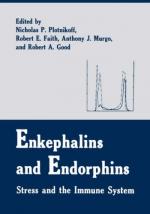|
This section contains 388 words (approx. 2 pages at 300 words per page) |
Endorphins are naturally produced polypeptides that are produced in the brain. Their physiological effect is similar to the analgesia (pain relief) of morphine. Chemically, they are classified as opioid-peptides and have 16-31 amino acids in their polypeptide chain. There are three main families of opioid-peptides including the endorphins, the enkephalins and the dynorphins. To date, four groups of endorphins (alpha, beta, gamma and sigma) have been identified. Beta-endorphins are the most potent endogenous opioid that affects both physiological and mental processes. The effects range from central nervous system and peripheral nervous system analgesia and pain modulation to effects on neuro-endocrine control of reproduction, stress, spontaneous behaviour and motivation. It has been found that prolonged physical exercise can increase production and release of endorphins that result in a sense of euphoria that is commonly referred to as "runner's high."
Endorphins are the body's natural way of toning down specific pain responses by binding with opiate receptors in the brain. Although endorphins act as neurotransmitters and neurohormones, their role in physiological processes is still not completely understood. One effect of endorphins binding to receptors in the brain may lead to an inhibitory neural response (due to activation of an inhibitory G-protein) or may lead to an excitatory response (hyperpolarization of the neuron) to the point that less neurotransmitter is released into the synaptic gap, resulting in decreased excitation of the neuron. Endorphins may also act to prevent the release of substance P that has been found to transmit pain impulses to the brain.
The search for endorphins began in the 1970s with the attempts to isolate opiate binding sites in the brain. Vincent Dole of Rockerfeller University did the early work in this area in 1970. In 1973, at Johns Hopkins University, Solomon Snyder and his graduate student Candace Pert isolated opiate receptors on nervous tissue. With the discovery of the receptor sites, the search for the molecules that bound to these sites intensified. In 1975, Choh Hao Li of the University of California at Berkeley isolated endorphins from a pituitary hormone that he had originally isolated in 1960. He named the biochemical endorphin that means "the morphine within." Endorphin research achieved worldwide recognition in 1977 with the awarding of the Nobel Prize in physiology or medicine to Roger Guillemin and Andrew Schally for their work on peptide hormone production of the brain.
|
This section contains 388 words (approx. 2 pages at 300 words per page) |


